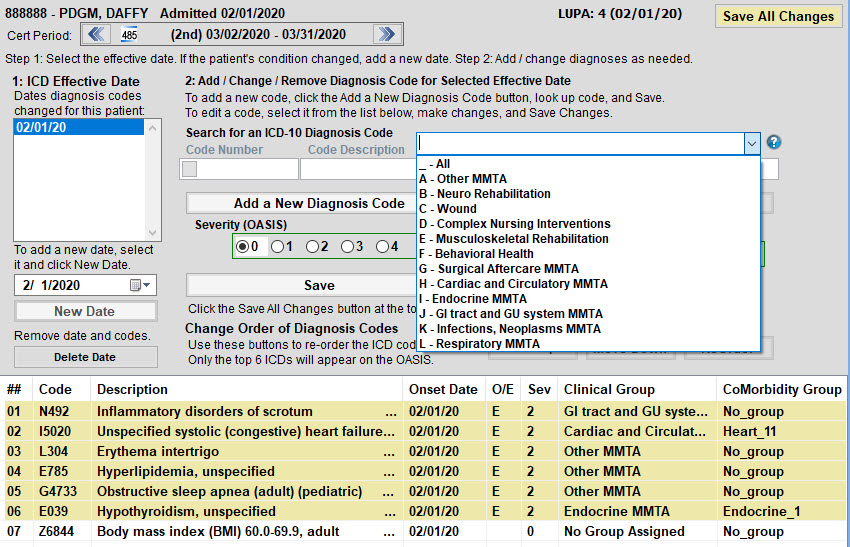Barnestorm diagnosis codes now incorporate Patient-Driven Groupings Model (PDGM). About 40% of the diagnoses allowed for under the current Prospective Payment System (PPS) will not be accepted as primary diagnoses under PDGM. To ensure ICD codes are acceptable, Barnestorm has provided a visual guide for accepted codes with a simple highlight, as well as a pull-down that filters by clinical grouping. Note that if a claim requires a HIPPS code then the primary ICD must be assigned to a clinical group.
To find a diagnosis code that is acceptable under PDGM, select a clinical grouping category above the code search before searching for the ICD code. This will filter only PDGM codes for you to choose from. You can still search by number or word as usual when seeking a code after you pick the category.
After you have selected the ICD code and saved it, the Clinical and CoMorbidity group will show up in the ICD list at the bottom of the screen. You may need to maximize your screen to see the CoMorbidity column, or you can size the columns to fit your screen. Yellow = assigned to a clinical grouping; Green = is scored in a comorbidity group.
The Cert Period dates shown will tell you the 30 day period and if it is the first or second set of 30 days within the 485 period. If the 485 icon does not show up then that means the 485 episode has not been generated yet.
Existing Patients: Make sure that the top listed ICD code has highlights and is the correct primary clinical grouping for that patient. Change the codes or move/reorder codes if not.
Your admin can run a report for any patients whose ICD codes need to be altered for PDGM.
Excerpt from MLN Matters SE19028 https://www.cms.gov/files/document/se19028
Payments for 30-day periods with a low number of visits are not case-mix adjusted, but instead paid on a per-visit basis using the national per-visit rates. Each of the 432 different PDGM payment groups has a threshold that determines if the 30-day period receives this Low Utilization Payment Adjustment (LUPA).
The top of the screen will generate the LUPA count based on one of two scenarios: A) An exact LUPA count will show if a recent OASIS with a HIPPs code is found. It will also show the M0090 date of the recent OASIS. B) If no OASIS is found it will give a range of LUPA counts based on all HIPPs codes in the primary clinical group selected.

Clinical grouping of the primary ICD code is the primary factor that drives the reimbursement rate.
PDGM clinical grouping is based on the principal diagnosis reported on the claim and CMS designed the groupings to capture the most common types of care provided. According to the Federal Register, the principal diagnosis provides information to describe the primary reason for which a patient is receiving home health services.
CMS originally specified six groupings. The number was doubled in the final rule, expanding the classifications from six to 12 with the addition of seven Medication Management, Teaching and Assessment (MMTA) subgroups. MMTA groupings represent about 55% of all projected 30-day periods.
The PDGM will classify each 30-day period of care by principal diagnosis into one of 12 clinical groups or subgroups:
- Musculoskeletal Rehabilitation
- Neuro/Stroke Rehabilitation
- Wounds: Post-Op Wound Aftercare and Skin/Non-Surgical Wound Care
- Complex Nursing Interventions
- Behavioral Health Care
- Surgical Aftercare Medication Management, Teaching and Assessment (MMTA)
- Cardiac/Circulatory Medication Management, Teaching and Assessment (MMTA)
- Endocrine Medication Management, Teaching and Assessment (MMTA)
- Gastrointestinal / Genitourinary Medication Management, Teaching and Assessment (MMTA)
- Infectious Disease/Neoplasms/Blood-Forming Diseases Medication Management, Teaching and Assessment (MMTA)
- Respiratory Medication Management, Teaching and Assessment (MMTA)
- Other Medication Management, Teaching and Assessment (MMTA)
Please see the abundant resources at CMS (and on Google) for more info on PDGM clinical groupings, coding, and reimbursement rates. Barnestorm staff will train you how to use the new clinical groupings on the ICD screen, and show you how to run a report of patients that you need to recode, but we are not able to code for you.